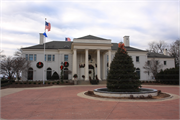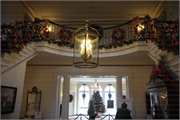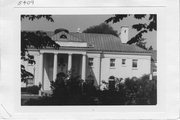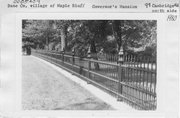Property Record
99 CAMBRIDGE RD
Architecture and History Inventory
| Historic Name: | CARL A. JOHNSON HOUSE |
|---|---|
| Other Name: | GOVERNOR'S RESIDENCE / Executive Mansion |
| Contributing: | |
| Reference Number: | 5409 |
| Location (Address): | 99 CAMBRIDGE RD |
|---|---|
| County: | Dane |
| City: | Maple Bluff |
| Township/Village: | |
| Unincorporated Community: | |
| Town: | |
| Range: | |
| Direction: | |
| Section: | |
| Quarter Section: | |
| Quarter/Quarter Section: |
| Year Built: | 1927 |
|---|---|
| Additions: | |
| Survey Date: | 1980 |
| Historic Use: | house |
| Architectural Style: | Colonial Revival/Georgian Revival |
| Structural System: | |
| Wall Material: | Stucco |
| Architect: | FRANK RILEY |
| Other Buildings On Site: | |
| Demolished?: | No |
| Demolished Date: |
| National/State Register Listing Name: | Not listed |
|---|---|
| National Register Listing Date: | |
| State Register Listing Date: |
| Additional Information: | A "site file" (Governor's Residence) exists for this property. It contains additional information such as correspondence, newspaper clippings, or historical information. It is a public record and may be viewed in person at the Wisconsin Historical Society, Division of Historic Preservation. The Wisconsin Executive Residence: A Short History Anna-Lisa Marie Dahlgren Since 1883, the State of Wisconsin has maintained an Executive Residence for the Governor. Two separate residences have served this function--the former on East Gilman Street in Madison, and the current on Cambridge Road in Maple Bluff. The first building served as the Executive Residence from 1883 to 1950, and the second from 1950 to the present. Both buildings began as private residences, and later made the transition to Executive Residences. The Gilman Street residence was built sometime around 1854-1856 for Julius T. White. White was a prominent local businessperson and later became a Union General during the Civil War, after which this house became known locally as "The White House." In 1857, White moved away from Madison and sold the house to George P. Delaplaine, who was the private secretary to Wisconsin's first two Governors. J.G. Thorp, a multimillionaire lumber baron who moved from Eau Claire to Madison, then purchased the house in 1868. The house became a showplace for Madison's social elite social during the 15 years that the Thorps resided there. Following that, Governor Jeremiah Rusk bought the house for $15,000, but sold the house in 1885 to the State of Wisconsin for an unknown price. From then until 1950, the Governor's Residence on East Gilman served as home to 18 Wisconsin Governors. Around 1949, the State expressed interest in moving the Executive Residence to the Carl A. Johnson House in Maple Bluff. Johnson was a prominent citizen who had a broad influence on state economic and social affairs. Born in Wisconsin on April 21, 1870 to Norwegian immigrant parents, Johnson was educated in the Madison public schools. In 1891, he graduated from the University of Wisconsin with a degree in Mechanical Engineering. His father, John A. Johnson, was an owner of the Fuller and Johnson Machine Company and founder of the Gisholt Machine Company. Gisholt produced machine tools-- machines that make parts for other machines. A very successful company, it won a gold medal at the 1900 World's Fair in Paris against the best machine tool companies in the world. It was through this company that his son worked his way up from the bottom to become company president. Johnson always kept his personal integrity and is credited by the Wisconsin State Journal with "humanizing industry" (WSJ 10-31-31). His many accomplishments and contributions to the city and state include: presidency of the Wisconsin Manufacturers? Association for seven years; presidency of the Madison Association of Commerce; and leader of a highly effective campaign to "Consume More Milk" in Wisconsin factories. He also served on the draft board and the Executive Committee of Wisconsin Manufacturers' Association. He firmly urged other industrialists to maximize their economic efficiency by trading in old and aging equipment for new machines. Furthermore, he maintained an undying commitment to being a humanitarian--during World War I, he turned over his home on East Gilman Street to be used as a hospital. He also generously financed the education of several dozen men through the University of Wisconsin. Former Wisconsin Governor Walter J. Kohler eulogized him saying, "He was a notably loyal, sincere, kindly man, characterized by an unusual sense of responsibility . . .in whatever concerned the development and well-being of Wisconsin" (WSJ 10-31-31). Carl A. Johnson recruited Madison architect Frank M. Riley in 1927 to design his new residence in Maple Bluff. Riley's credentials made him a clear choice for the job. Born in 1875 and raised in Madison, Riley was also educated in the public schools of Madison, until he enrolled at UW-Madison in 1894 to study Civil Engineering. In 1897, Riley transferred to the Massachusetts Institute of Technology (MIT) in Boston where he discovered his passion for architecture. After studying for three years at MIT, he entered the architectural profession as a draftsperson, where he gained practical experience. Over the next decade, Riley traveled abroad to countries like England, Germany, and Italy, sketching historic buildings to add to his architectural repertoire. In 1914, he returned to Madison, Wisconsin where he spent the remainder of his life. There, he designed an abundance of both private and public buildings, from individual buildings to whole subdivisions. During Riley's early practice in Madison, he designed the current UW System President's Residence--a large Colonial Revival style home in the Highlands. By first designing large public buildings like the Madison Club, he established a solid reputation as a designer and much of Madison's elite class solicited him to design their new residences. Upon Riley's return to Madison, he discovered that many of Madison's citizens were moving out of Madison's crowded downtown area to new suburbs like Maple Bluff. Best known for his period revival designs, Riley agreed to design Carl A. Johnson's new Georgian style home for a four-acre site in Maple Bluff. In the May 24, 1949 the Wisconsin State Journal summarized his personal style and architectural accomplishments: "He not only studded the Madison scene with beautiful homes, but he set a standard which had a strong influence on other designers and builders. He had an eye for detail and a sense of proportion and balance. He insisted his houses should have dignity, charm, and look "lived in". . His contribution to Madison's reputation as a city of beautiful homes was an important one." Carl A. Johnson's home was finished in 1927, but he only enjoyed his magnificent new home for four years. Johnson's death resulted in the sale of the property to Thomas R. Hefty. Hefty, the son of Swiss immigrants, was born in New Glarus in March of 1885. He served in World War I and, when he returned, he became Vice President of the First National Bank. Four years later, at the age of 41, First National promoted him to president. In early 1949, the State of Wisconsin began to show interest in buying the Johnson house for its new Executive Residence, though the idea met with resistance from state officials. The mother of Wisconsin Governor Jim Doyle, Assemblywoman Ruth Doyle, led the opposition mainly because of her concern about the future of the then current Executive Residence at East Gilman Street. She feared that the state government would let the home "pass into private hands . . . [because] a lot of important history is tied up with the house at Gilman St." (WSJ 5-21-49). Consequently, the state Senate was unable to reach a decision, delaying action on the bill. The next time the bill was raised, the senate debated for an hour and a half. Mrs. Doyle read a letter from Madison attorney and federal court commissioner James McManamy stating that this purchase was "a wanton waste of the tax-payers' money" (WSJ 5-26-49). As it turned out, the senate authorized purchase of the Johnson house for $47,500 by a vote of 59 to 35. Mr. and Mrs. hefty sold the house to the State on July 1, 1949. The old Executive Residence became graduate student housing for Knapp Scholarship students at the University of Wisconsin. Few significant changes have occurred to the Johnson house under state ownership. In 1965, the State Legislature approved state money for a major renovation and refurnishing. The work had little effect on the building's appearance and focused on upgrading heating, electrical wiring and plumbing; installing air conditioning, and replacing the kitchen and a bathroom. Throughout these changes, then-Governor Warren P. Knowles and his wife resided at the old Executive Residence on Gilman Street. In 1969, the State installed a decorative wrought iron fence bordering Cambridge Road, which encircled the capitol grounds from 1872-1899. Since that time, the Governor's Residence has received regular maintenance and system upgrades. Major projects such as rebuilding outdoor terraces and replacing the deteriorated wooden columns have been respectful to the original design and character of the home. Continuing with Riley's original intention of looking "lived in," the committee responsible for these changes realized that the house must, "have a degree of dignity, but since it is in essence a home, it was also important that it have a relaxed atmosphere." (Architectural Digest, Sept-Oct 1970). The Executive Residence in Maple Bluff continues as the official governor's residence. |
|---|---|
| Bibliographic References: |
| Wisconsin Architecture and History Inventory, State Historic Preservation Office, Wisconsin Historical Society, Madison, Wisconsin |





